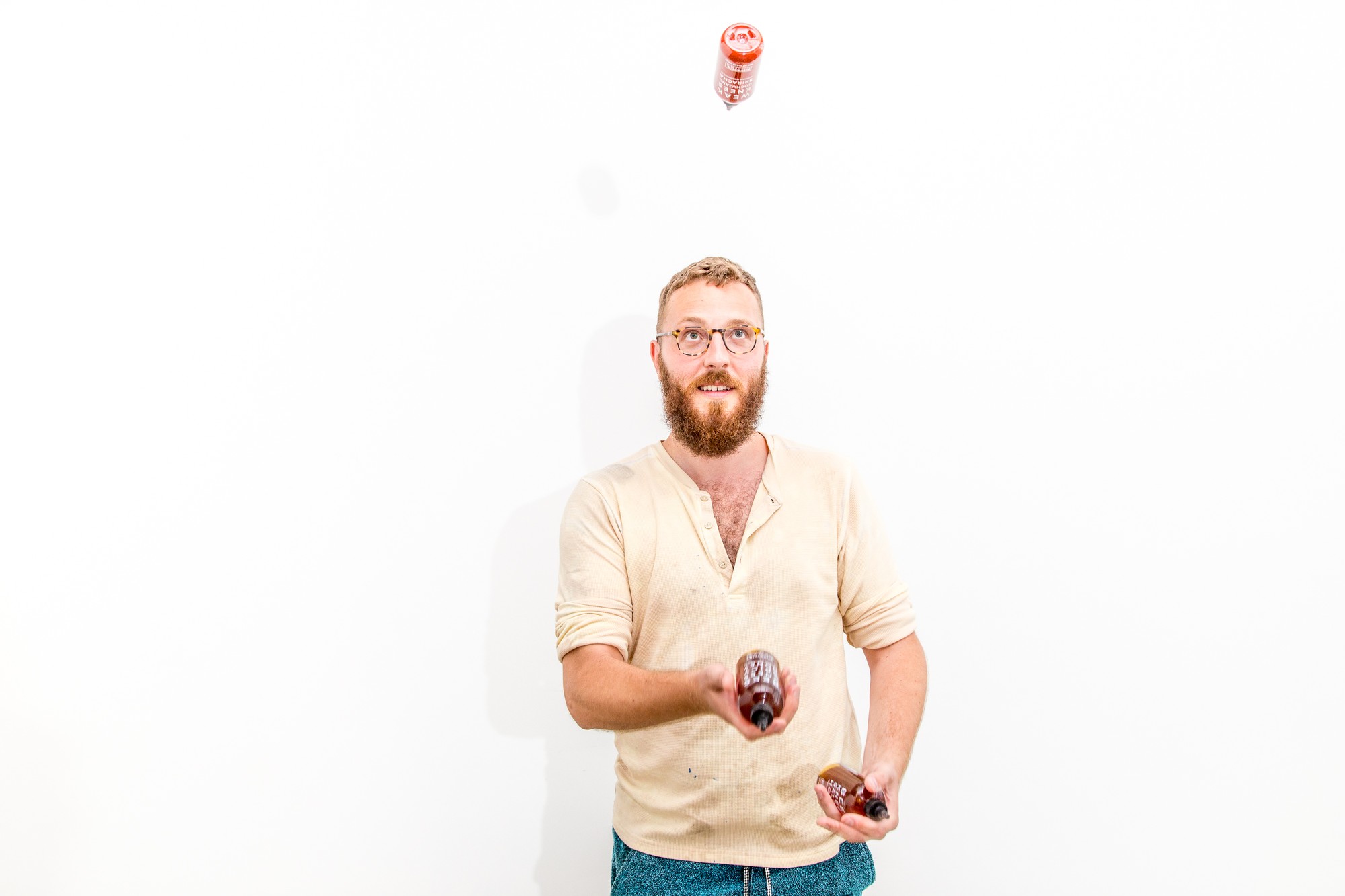Welcome to Eat Sleep Instagram , our weekly series of conversations with the people behind the most drool-worthy Instagram accounts about how they’re navigating the digital age, deliciously.
This week, Taste Talks photographer Mackenzie Anne Smith caught up with Bushwick Kitchen’s Casey Elsass , who talks about his early days of social media oversharing, starting a Brooklyn business, and maple syrup.
____________________
Tell me about your experience with Instagram.
Well, before the business began I had a personal Instagram account. It’s funny, I feel like I’m sharing my first AOL screen name or something. But, it was @the_case. A lot of my friends called me The Case… there was a period of time when I went really hard on Instagram, and it sort of became part of my persona: my life in real time, and I was very open about sharing a lot there. I wasn’t sharing anything too personal, but I was sharing a lot of myself and I got pretty burnt out with it.
How long was The Case on the internet?
I think The Case’s reign was 2012-2014.
When did you start the Bushwick Kitchen Instagram?
We started working on Bushwick Kitchen (BK) in February 2014. And by that point, I had definitely stopped posting on @the_case. The account still existed, but I hadn’t posted on it since the Fall.
Did you have a lot of followers?
I did. Not like tens of thousands of followers, but a couple thousand followers, back when that meant something.
Wow, so did you use @the_case to promote your new business?
No. I didn’t. Which, in retrospect, I really regret.
THAT IS SHOCKING.
It was stupid. And if I could go back, I absolutely would. But I think I was just very eager to get rid of that account, so I deleted it and started again from scratch.
 Casey learned to juggle for this shoot. photo: Mackenzie Anne Smith
Casey learned to juggle for this shoot. photo: Mackenzie Anne Smith
So @the_case is dead.
The Case lives in me. But on the internet, gone.
Did you make a plan for building Bushwick Kitchen’s Instagram account?
Bushwick Kitchen happened in a couple of phases. Phase one was purely an experiment. My friend and I took 30 days to see if we could start a business from scratch. We put our own money into that experiment and figured we would make enough Bees Knees Spicy Honey to make back that investment. And maybe, if it were easy to automate, keep it running at a very slow burn and pull some pocket change. But within 4 months, the product just took off. I was no longer able to keep up with that plus my full-time day job and I needed to make a choice between the two of them.
Phase 2 of the business was when I decided to quit my job and commit to Bushwick Kitchen full-time. That’s when I started to get serious about it and cleaned up our website, made social media accounts, etc. And that didn’t happen until a good 4 months into the business. At that point the project had expanded beyond our friend group, and when it’s just your friends… I mean, cute to have an Instagram I guess, but your audience already knows what you’re doing. When strangers from across the country started to order product, I felt like we should start thinking about an identity on Instagram.
This may seem like an easy question, but why is it important for strangers from across the country to follow you on Instagram?
Actually, I think that’s a very hard question, because I am still trying to figure out how a brand operates on social media and that’s something I’ve been struggling with from the beginning. I think our aesthetics and our tone are very clear, but keeping a consistent presence and nailing down the information and type of content we should be offering 5 times a week is tricky. It’s also difficult because with Instagram it only translates into dollars in very specific scenarios. Most of the time, at least from my perspective, the instances of a post translating into sales on our site are when someone else is posting about our product. And we know that our followers really respond to food pics with the bottle in the shot. Bottles by themselves get a lot of likes, food pictures with no bottle get medium likes, and pictures that are not of food or product get very few likes. So the combination of food + bottle is the magic formula. But how do you sustain that over and over without getting stale? And when do you throw in an oddball post for variety? That’s what I’m questioning right now.
Can you tell when those likes turn into dollar signs?
It’s hard to track from Instagram to our website. But, there have been times when (and I hate the word influencer, but there is no other word for it) an influencer posts something and the traffic to the website would be too coincidental for it not to be connected to the Instagram post.
Back in October 2015, Absolut Vodka contacted us about doing an Instagram campaign to highlight their local and handcrafted ingredients. We shot a carousel slideshow featuring cocktails and food using Bees Knees, Trees Knees and Weak Knees. And because it was a sponsored post, we were able to tap into Absolute’s metrics and track directly from the post to our website.
So even though you still have some questions about the perfect recipe for cookin’ up a solid brand presence on Instagram, if you were to give advice to a new company selling a food product, what would you say, other than make sure the product is in the shot (which seems like pretty tangible advice)?
Well, that’s only the magic formula for our brand—another product might merit a completely different set of guidelines. But I would say, pay attention to the feedback you’re getting from your followers. It will be hard to do at first because any new Instagram account is going to be made up of people you know, who are just going to like your pictures because they like you and they want to support you. But once you get past that phase where more and more strangers are the majority of the followers on your account, pay attention attention to what gets responses and go in that direction. Be very thoughtful about the pictures you are taking. Instagram is completely visual medium. A lot of people love to write paragraphs under their pictures, but I really think people respond to gorgeous photos first and foremost. Take the time and make the effort to take beautiful pictures. If it’s not 100% to your satisfaction, do it over. Don’t put a mediocre picture on Instagram because they just stick out like sore thumbs. It’s important to not copy, not to mimic, but to pay attention to what people are doing in any sphere, not just in food. Look around and see what’s happening, pull some influence, get some ideas and then figure out what that’s going to look like for your brand.
You started a new Instagram account around the time that your Maple Short Stack was published back in February of this year. Were those two things connected for you?
Yeah, absolutely. Maple was coming out and I had some speaking engagements booked, and both of those things were tangentially involved with Bushwick Kitchen, but it was also me as an individual doing those things. Short Stack posts about their authors and I felt like it would be better for all of us if they were posting about Casey Elsass and not another brand. Conferences are covered by the people sitting in the audience on their cell phones, and if I’m up there speaking, they are going to go looking for me on Instagram, and it’s probably beneficial that I am there waiting for them. Yeah, it’s a weird thing to talk about it like this, but it’s the truth. People expect you to be on social media if you have any sort of public presence.
In both cases, @BushwickKitchen and @caseyelsass exist for you as a professional.
Yeah. @caseyelsass skews more personal, but nowhere near as personal as @the_case. It’s still where I am and what I’m doing, but I feel a little bit more protective about what I’m sharing there. @bushwickkitchen is all about the products and the brand, and I don’t want to be a presence on our brand.
Interesting. So many makers these days stay very close to their brand as they grow.
I’ve thought a lot about that, because it is a great tactic to make yourself into your brand’s persona. And I am the sole public voice and face of the brand, I do all the interviews and speaking engagements and social media posting. But this brand is not me. I mean it is, because I built it and I make it and I run it and I own it. But I want our products to stand on their own separate from myself, so we’ve actively decided that the brand image on social media has nothing to do with any one person in the company, it’s all about what we’re making.
When you got rid of @the_case, did you feel any sense of loss when you didn’t have a place to put your pictures to tell people about what you were up to?
No. The pendulum swung one way for a period of time on Instagram, and then it really swung the other way for me. It was great. I finally would go places, and not even think to pull out my phone and take a picture, and it was nice to be present and just enjoy things without documenting them. But, as the sole provider for the company Instagram account, I did need to be thinking about constantly producing content. It was hard to drag myself back into the mindset of capturing images and reframing them for an audience. Once I started my own personal account again, I made a challenge with myself that any time I post a photo on my personal account, I have to also post a photo on Bushwick Kitchen’s account. I feel like I can’t be giving my own account more time and attention than my company’s account which is really where I should be focusing. So if I have no photo to share on BK, then I’ll scroll through our tagged photos and find someone else who has posted a great picture and regram that. That way I won’t have to feel guilty that I’m posting vacation photos on my personal account and no photos on the company’s account.
Sounds like a pretty good deal.
Well, in the recent weeks, I’ve definitely been spending more time on my personal account, but it’s the summer!
Do you use anything to track your metrics?
Not really. So we’re over 5,000 followers now, which is funny in 2016 because that’s nothing on Instagram anymore. Back in 2014 5,000 followers was really something. Now people have hundreds of thousands of followers so 5,000 feels like a drop in the bucket. But, that’s 5,000 people looking and responding and interacting, and it can be an overwhelming amount of information. Sometimes it’s easier to not open the BK account because I know there will be comments and tagged photos that require a response and once I see them I’m sucked in for the next 30 minutes.
So do you allot a certain amount of time to work on social media for BK per week, per day?
I wish I could say I did. Social media is the easiest thing to let slide, because there is no consequence for not doing it even though there is an enormous benefit to doing it. But when you have a to-do list that’s a mile long, particularly when you make and ship your own product, it just becomes very easy to get wrapped up in all of the other things I need to do and not be strict with myself and take the time to plan what the next two weeks, or even two days, are going to look like on social media. It’s something I want to get better at, but I’m also starting to understand why companies hire people into that position. It’s a lot of thought and time to produce and conceptualize content, and to do it well it takes a very dedicated mind.










